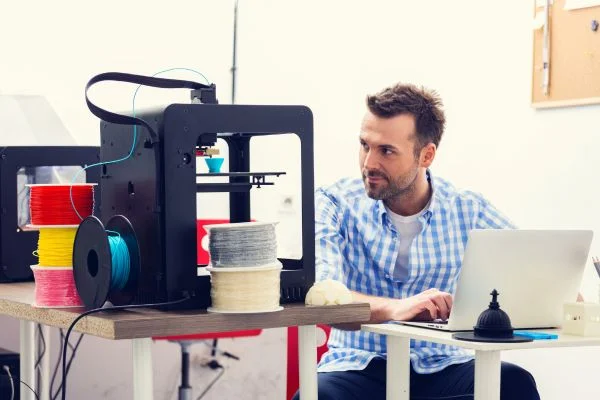In 3D printing, achieving a perfectly level printing surface is crucial for obtaining high-quality prints. To simplify this process and enhance user experience, 3D printer manufacturers have developed an innovative solution known as auto bed leveling. This technology utilizes sensors and algorithms to adjust the printer’s build platform automatically, ensuring optimal calibration for each print. This article will explore How Does 3d Printer Auto Bed Leveling Work, its benefits, and its impact on the 3D printing process.
The Need for Bed Leveling in 3D Printing
Bed leveling refers to aligning the printer’s build platform parallel to the print head’s movement plane. A perfectly level bed ensures that the first layer adheres uniformly to the build surface, preventing issues such as uneven extrusion, poor layer adhesion, or warping. Traditionally, manual bed leveling required users to adjust various screws and knobs to achieve the desired level, a tedious and time-consuming process often requiring repeated trial and error.
Read more about Do I Need Auto Bed Leveling 3d Printer?
How Does 3d Printer Auto Bed Leveling Work

Auto bed leveling simplifies calibration by incorporating sensors and software algorithms into 3D printers. These sensors measure the distance between the print head and the build platform at multiple points, providing precise feedback on any bed-level irregularities. The printer’s firmware uses this data to automatically adjust the Z-axis height during printing, compensating for any unevenness in the build surface.
Sensor Technologies in Auto Bed Leveling
There are several sensor technologies commonly used in auto bed leveling systems:
a. Inductive Sensors: These sensors detect changes in the magnetic field when they come close to conductive surfaces, such as a metal print bed. They provide reliable measurements without physically contacting the surface.
b. Capacitive Sensors: By measuring changes in the electrical capacitance between the print head and the build surface, capacitive sensors can detect the distance accurately. They are often used with non-metallic or glass print beds.
c. Mechanical Switches: Mechanical switches are simple contact-based sensors that detect when the print head physically touches the build surface. They are commonly used in printers with flexible or removable build surfaces.
d. Optical Sensors: Optical sensors use infrared or laser beams to measure the distance between the print head and the bed. They can work on various surfaces, including transparent ones.
Read more about How To Add Auto Leveling Bed To 3d Printer?
Auto Bed Leveling Algorithms
The sensor data collected during the leveling process is processed using advanced algorithms by the printer’s firmware.
These algorithms analyze the deviations in the measured values and calculate the necessary adjustments to the Z-axis height to compensate for any unevenness in the bed. The adjustments are made dynamically during the print, ensuring that each layer is accurately deposited onto the build surface.
To perform the leveling, the printer usually runs a set of predefined patterns, such as a grid or a series of probing points, to measure the distances at different locations on the bed. The firmware then creates a mathematical model of the bed’s shape and calculates the required changes to achieve a level printing surface. If you know auto bed leveling algorithms then knowing how does 3d printer auto bed leveling work is very easy.
Benefits of Auto Bed Leveling
Auto bed leveling in 3D printers offers both beginners and experienced users several significant benefits. Let’s explore some of the key advantages:
1. Improved Print Quality

A level bed is essential for obtaining high-quality prints. Auto bed leveling ensures that the first layer of the print adheres uniformly to the build surface.
Compensating for any unevenness or tilt in the bed helps prevent issues like uneven extrusion, layer shifting, or warping. This results in more accurate prints with better layer adhesion and surface quality.
2. Time and Effort Savings
Manual bed leveling can be time-consuming and frustrating, especially for those new to 3D printing. Auto bed leveling eliminates manual adjustments, saving users significant time and effort.
It simplifies the initial setup of the printer, as well as the preparation between prints. Users can focus more on the design and creative aspects of 3D printing rather than spending time on intricate calibration processes.
3. Enhanced User Experience
Auto bed leveling technology enhances the overall user experience by making 3D printing more accessible and user-friendly.
Beginners can start printing with minimal knowledge of bed leveling techniques, reducing the learning curve associated with manual calibration. This feature encourages more individuals to explore and experiment with 3D printing, opening creative expression and innovation opportunities.
4. Versatility with Different Bed Surfaces
Auto bed leveling systems can accommodate various print bed surfaces, including glass, metal, or flexible build plates.
Different sensor technologies, such as inductive or capacitive sensors, allow for reliable measurements on other materials. This versatility enables users to choose the type of bed surface that best suits their printing needs without sacrificing the convenience of auto bed leveling.
5. Consistency and Reliability
Auto bed leveling ensures consistent printing results across multiple prints. Once the initial calibration is performed, the system maintains the levelness throughout the printing process.
This consistency reduces the risk of failed prints due to improper bed leveling, minimizing material waste and saving costs. Users can rely on the technology to provide reliable and repeatable printing results.
6. Adaptation to Environmental Changes
Temperature fluctuations or slight movements in the printer’s frame can affect the level of the bed. Auto bed leveling compensates for these environmental changes by continuously monitoring the print bed during printing.
It makes real-time adjustments to the Z-axis height, ensuring the print remains level and accurate even if slight variations occur.
7. Compatibility with Multiple Printer Models
Auto bed leveling is available on a wide range of 3D printer models in consumer and professional segments. Many manufacturers include this feature as a standard or optional component, making it accessible to users with different budgets and requirements.
Whether you have a desktop printer or an industrial-grade machine, auto bed leveling can be a valuable addition to enhance your printing experience.
Read more about How To Remove Raft From 3d Print?
Bottom Line
Now you know, How Does 3d Printer Auto Bed Leveling Work. Auto bed leveling technology revolutionizes the calibration process in 3D printing, making it more accurate, convenient, and accessible. By automatically compensating for any unevenness in the build surface, this innovation enhances print quality while reducing user effort and frustration. As the 3D printing industry evolves, auto bed leveling is expected to become a standard feature in modern printers.

